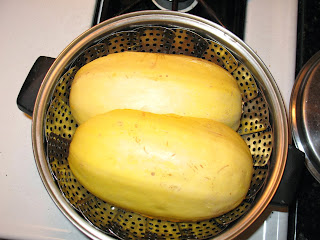My wife and I both love spaghetti, and we keep a good supply
of angel-hair pasta in our food storage; but in a long term survival situation,
we will eventually run out of pasta. No
more spaghetti. Of course you can make
your own pasta, but if you’ve ever done that you know it’s a lot of work; and
that’s if you already have the flour. So, we were looking for another
alternative.
A couple of years ago a friend asked if we’d ever tried
spaghetti squash. I told her that we had
not; in fact I didn’t even know what spaghetti squash was. She proceeded to tell me how to prepare it so
we gave it a try. It tasted great and it
was totally crazy to see what looked like spaghetti coming out of the inside of
a squash. Many of you have probably tried
spaghetti squash, but some of you, like me, may not even know what it is. Here is a brief tutorial on how to prepare
spaghetti squash for those who don’t already use it.
First take a spaghetti squash and cut it in half. It takes a good sharp, serrated knife to do
this because the skin is pretty tough.
Next, take a spoon and scrape out the seeds from the inside
of the squash. If it’s an heirloom be
sure to save the seeds.
Place a steaming rack into a good size pot of water and
bring the water to a boil.
Place the halves of spaghetti squash, cut side down, on the
steaming rack, cover, and let it steam for twenty minutes or so depending on
the size of the squash.
Remove the squash from the steaming rack. Use hot pot holders because it will be very
hot.
Take a fork and begin scrapping the flesh out of the squash
and into a bowl. As you scrape, the
flesh will come out in little strands that look like spaghetti. It is really freaky looking, the way it comes
out.
I like to add butter, salt, pepper, and garlic to the
strings of squash and stir it all in.
Dish a serving out onto a plate, pour hot spaghetti sauce on
top, and you are ready to eat.
If you have electrical power you can cook the squash in your
microwave. Take the whole squash and poke
eight or ten holes down into the center with an ice pick. Microwave the squash on high for ten or
twelve minutes, cut the squash in half, scrape out the seeds, and remove the
flesh.
We love spaghetti made with spaghetti squash. After we tried it the first time, we new this
was a winner. In fact, I don’t think
we’ve eaten regular pasta since then. I
went to a feed store in a near-by town that carries a full line of heirloom
seeds, and I bought a bag of spaghetti squash seeds. These seeds; along with the heirloom
tomatoes, onions, garlic, and herbs that we grow; mean that we will now have a
lifetime renewable source on spaghetti for our dinner table.



























































